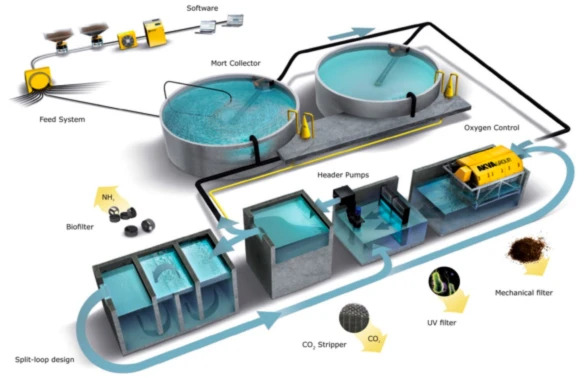
Recirculating Aquaculture System
The RAS is a unique technology of farming which ensures high production volume in a small footprint of land, high quality of fish and continuous year-round supply. In addition, the system is flexible, highly productive, energy efficient and environmentally friendly.
This system is significantly less costly considering the project production volume and is affordable by a large cross-section of fish farmers and aquaculture entrepreneurs. Return of Investment (ROI)from 3 to 5 years depending on species and sales price.
All RAS relies on biofiltration to convert ammonia (NH4+ and NH3) excreted by the fish into nitrate.[4] Ammonia is a waste product of fish metabolism and high concentrations (>.02 mg/L) are toxic to most finfish.[5] Nitrifying bacteria are chemoautotrophs that convert ammonia into nitrite then nitrate. A biofilter provides a substrate for the bacterial community, which results in thick biofilm growing within the filter.[4] Water is pumped through the filter, and ammonia is utilized by the bacteria for energy. Nitrate is less toxic than ammonia (>100 mg/L), and can be removed by a denitrifying biofilter or by water replacement. Stable environmental conditions and regular maintenance are required to ensure the biofilter is operating efficiently.
RAS System
The rate of adoption of RAS in the aquaculture industry has been growing fast worldwide. The service provider of high-end RAS Technology provides total turnkey solution covering-site assessment, project design, the supply of equipment and installation, training and management of intricate fish biology.
India is in the verge of an aquaculture Revolution. the demand of fish is increasing in the domestic market. The export market is also expanding at a very fast rate. On the contrary, the supply of fish is becoming less & less due to overfishing from natural sources, limitations of land availability for aquaculture,low productivity, disease outbreak related to land based aquaculture system etc. While all these are naturally unavoidable, AS technology is providing a unique solution.
Ras features and advantages:
- Culture density of 20-60 KG/ M3 or more against 1-2 kg / M3 in a traditional outdoor open pond.
- A very small area of land requirement compared to regular extensive open pond culture. only 500-600 M2 required to the setup of 10 tonnes per year as against 4-5acres required for pond based culture.
- Suitable for farmers and entrepreneurs having marginal land. even it can be set up in rented premises can be set up near urban centers to have larger market access.
- Culture is carried out in Indoor tanks in a closed shed ensuring a bio-secure environment.
- The system is perfectly suitable to produce a local variety of fish.
- The system allows many times higher production capability in comparison to any other aquaculture system including traditional outdoor open pond culture.
- Significantly less manpower required than that of the traditional outdoor open pond system.
- Modular in design has the potential for future expansion. an existing unit can always be expanded by just adding modules.
- Around 85% of the system water is recirculated thereby reducing water requirement drastically filter of waste, feed Residues and dissolved toxics impurities.
- Around 90% removal of TAN(total Ammonia and nitrogen) and degassing by biofiltration.
- The fish species grown under this system are almost uniform in size healthier as well as test better.
- Optimum feed conversion ratio (FCR) with pellet /floating feed.no scope of feeding crude / raw proteins (e.g. Viscera/dead animals/blood etc.).high protein floating feed required for the culture are widely available in India.
- Fish cannot escape from the tank which is common in outdoor open pond fish culture.
- Sustainable culture for producing clean fish free from all chemical and much tastier than pond cultured fish since raised in pure water with high-quality feed throughout their life cycle in a sense it is organic fish commanding a better price than regular.
- Very less chance of getting disease free from all natural calamities (rain, flood, drought etc.) And predators ( birds and animals). Being indoor, project is free from theft and other hazards(adding poison etc).
- Being almost uniform in size grading and harvesting is much easier for marketing.
- The wastewater is highly nutrient liquid biofertilizer which can be utilised in agricultural farming ensuring added income farmers / entrepreneurs having additional land can go for aquaculture and vegetables / Cash crop farming project wherein the waste water from the Ras project can be utilised as high-grade organic / biofertilizer and fulfilling some irrigation needs.the resulting product can be sold in supermarkets as high value organic product.
- Sustainable farming practice and absolutely zero environmental impact.
- Entrepreneurs / farmers having a bigger size of projects in mind can go for setting up a number of units on the same premises. with the option of raising different high-profit species in different units thereby increasing the marketing and financial viability RAS features and advantages
.png)